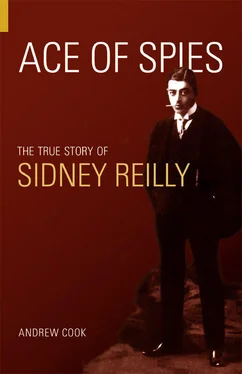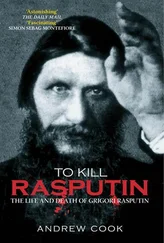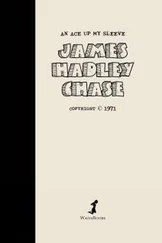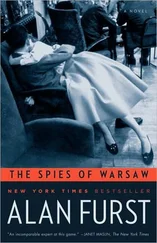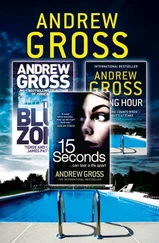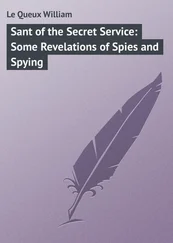24. Ibid. (attached to letter).
25. Ibid. (attached to letter).
26. Memorandum from SIS to MI5, dated 30 January 1918 (Sidney Reilly’s MI5 File PF 864103).
27. Memorandum from MI5 to SIS, dated 2 February 1918 (Sidney Reilly’s MI5 File PF 864103).
28. Entry No. 475, Register of Deaths in the Registration District of Wandsworth, in the Sub-district of South West Battersea, 1 February 1918.
29. Telegram No. 206 of 28 February 1918, from C to SIS New York.
30. Telegram CX 021744, CMX 188, received London 10.00 a.m. 4 March 1918 ( Reilly Papers CX 2616).
31. Observation reports dated 6–9 March 1918 (Sidney Reilly’s MI5 File PF 864103).
32. Report dated 9 March 1918 (Sidney Reilly’s MI5 File PF 864103).
33. Telegram CX 023100, CMX 201, received London 2.20 p.m. 14 March 1918 ( Reilly Papers CX 2616).
34. 2 Whitehall Court (today part of the Royal Horseguards Hotel) was designed by the architects Archer and Green and built in 1884. Conveniently situated opposite the War Office, it was, to all intents and purposes, a faceless apartment block. C had commandeered the top floor and rented it under the name of Capt. Spencer (Kelly’s Post Office Directory 1918).
35. Red Dusk and the Morrow, Sir Paul Dukes (Williams and Norgate, 1923), p.9. In Ace of Spies, p.98, Robin Bruce Lockhart states that ‘when Dukes was summoned for his first interview with the Secret Service chief, Reilly was present at the meeting and endorsed Cumming’s selection’. However, it is clear from Dukes’ own account that the interview took place in July 1918 when Reilly was in Russia (The Story of ST25, Sir Paul Dukes, Cassell, 1938, pp.28–29.
36. Diary of Mansfield Cumming – 15 March 1918.
37. Telegram CX 023996, CXM 212, received London 2.25 p.m. 21 March 1918 ( Reilly Papers CX 2616).
38. Diary of Mansfield Cumming – 22 March 1918.
39. Memorandum from MI5 to Irish Command, dated 22 March 1918 (Sidney Reilly’s MI5 File PF 864103).
40. Memorandum from Irish Command to MI5, dated 31 March 1918 (Sidney Reilly’s MI5 File PF 864103).
41. The prefix ST refers to the SIS station through which Reilly was reporting – Stockholm.
1. Telegram CXM 159, dated 29 March 1918 ( Reilly Papers CX 2616).
2. Letter from Stephen Alley to Robin Bruce Lockhart, dated 13 May 1966, Box 6, Robert Bruce Lockhart Collection, Hoover Institution Archives, Stanford, California.
3. Telegram dated 22 March 1918, 5.25 p.m. (Sidney Reilly’s MI5 File PF 864103/V1).
4. The fact that C also refers to Reilly as ‘Reilli’ in his telegram CXM 159 of 29 March 1918 strongly suggests that this misspelling is intentional.
5. Ibid., note 34.
6. US Bureau of Investigation/ONI, Report dated 16 September 1918, p.1, from Chief Yeoman Bond to H. Hunnewell and A. Smith.
7. Gen. Edward Spears recalled Reilly telling him of ‘a valuable collection of coins and Napoleonic relics’ he wanted to retrieve. It is also apparent from Spears’ letter that some or all of this collection was still in Russia in 1925 (letter to Robin Bruce Lockhart dated 2 January 1967, Box 6, Robert Bruce Lockhart Collection, Hoover Institution Archive, Stanford, California.
8. Telegram CX 027753, dated 16 April 1918 ( Reilly papers CX 2616).
9. Ibid.
10. Memoirs of a British Agent, Robert Bruce Lockhart (p.276).
11. Ibid.
12. The following month Foreign Secretary Arthur Balfour cabled Lockhart castigating his judgement and advice: ‘You have at different times advised against Allied intervention in any form; against it by the Japanese alone; against it with Japanese assistance; against it at Vladivostock; in favour of it at Murmansk; in favour of it with an invitation; in favour of it without an invitation since it was really desired by the Bolsheviks; in favour of it without invitation whether the Bolsheviks desired it or not’. ‘Lockhart Plot or Dzerzhinskii Plot?’, R.K. Debo, pp.426–427.
13. Sidney Reilly – The True Story, Michael Kettle, p.24; Ace of Spies, Robin Bruce Lockhart, pp.67–68; Master Spy, Edward Van Der Rhoer, pp.24–25.
14. Telegram CX 013592, sent from Moscow on 12 May 1918 (PRO WO 32/5669).
15. Telegram CX 035402, sent from Moscow on 29 May 1918 (PRO WO 32/5669).
16. Ibid.
17. Telegram CX 035176, sent from Moscow, 3 June 1918 (PRO WO 32/5669).
18. Dagmara Genrikhovna Karozus was not, as suggested by previous writers, a Russian. She was in fact German, and as such had been on Department of Police files since 1914 (Fond 102, 6 deloproizvodstvo, opis 174, delo 69, tom 30, listy 37-40, 1914, State Archive of the Russian Federation, Moscow).
19. Personal file of Elizaveta Emilyevna Otten, Inventory 6, edinitsa khranenija 120, Obraztsov State Academic Theatre, Moscow.
20. Account of the trial proceedings of the Supreme Tribunal, Moscow, of 29 November 1918, as reported in Izvestia, 1 December 1918.
21. Vladimir Grigoryevich Orlov (1882-1941), a former counter-intelligence officer in the First World War, who served in the Criminal Department of the Cheka in Petrograd. To conceal his real identity he adopted the name Boleslav Orlinsky. In September 1918 he fled to Finland and later served on Denikin’s counter-intelligence staff in the Civil War. In 1920 he settled in Germany where he continued his fight against the Bolsheviks by publishing compromising material about them in the western press. He was thought to be the prime suspect in connection with the forged Zinoviev letter, although nothing was ever proven. He was shot by the Gestapo in 1941 for anti-Nazi activity.
22. Master Spy, Edward Van Der Rhoer, p.224ff; History of the Russian Secret Service, Richard Deacon, p.264ff; Reilly – The First Man, Robin Bruce Lockhart, p.55; ‘The Terrorist and the Master Spy: The Political Partnership of Boris Savinkov and Sidney Reilly, 1918–25’, Richard Spence, Revolutionary Russia, Vol. 4, No. 1, June 1991, p.120ff.
23. Master Spy, Edward Van Der Rhoer, p.47.
24. Account of the trial proceedings of the Supreme Tribunal, Moscow of 29 November 1918, as reported in Izvestia, 1 December 1918.
25. The Hotel Elite was situated at 2 Petrovka Street, ten minutes walk from the Bolshoi Theatre. It was later renamed the Hotel Aurora, after the battleship which fired on the Winter Palace during the Great October Revolution. It is known today as the Budapest Hotel.
26. Memoirs of a British Agent, Robert Bruce Lockhart, pp.314–16, ‘Final Report of Robert Bruce Lockhart to Foreign Secretary Balfour’, dated 7 November 1918 (PRO FO 371/3337/185499).
27. ‘Final Report of Robert Bruce Lockhart’, Ibid.; ‘Report of Work Done in Russia’ by Capt. George Hill (PRO FO 371/3350/79980).
28. Reilly’s tactic of ‘divide and rule’, referred to by Nadine as his ‘system’ (US Bureau of Investigation/ONI, Report from Chief Yeoman Bond to H. Hunnewell and A. Smith, dated 10 September 1918), is discussed in Chapter Seven in the context of his dealings with Blohm & Voss.
29. Memoirs of a British Agent, Robert Bruce Lockhart, p.316.
30. FO 371/3348, No. 190442, dated 5 November 1918.
31. George Hill was initially assigned to Military Intelligence after being discharged on 13 June 1915 as a result of being wounded in France. He undertook assignments in the Balkans, Egypt and Russia for the director of Military Intelligence at the War Office, before being assigned to SIS in 1918. In his 1932 account of this period (Go Spy the Land) he refers to himself as Agent IK8 of the British Secret Service. However, ‘IK’ does not appear to be an SIS prefix and one must therefore assume that it was a code name given to him by Military Intelligence. While operating in Russia on behalf of SIS, Hill had an ST prefix like all other agents in this field of operation (Service File No. 51224, Capt. George A. Hill, Canadian Department of National Defense; Army Service Record of Capt. George A Hill (PRO Pi 15714)).
Читать дальше
